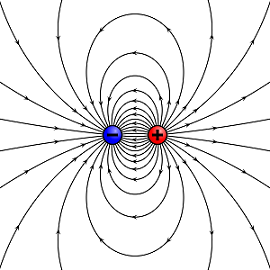Electric dipole: Difference between revisions
J.williams (talk | contribs) m (1 revision imported) |
energy>Jmdonev No edit summary |
||
| Line 1: | Line 1: | ||
[[Category:Done | [[Category:Done 2020-02-29]] | ||
[[File:600px-VFPt dipole electric manylines.svg.png|right|thumb|Figure 1. A dipole showing electric field lines from a positive and negative charge.<ref>[GFDL (http://www.gnu.org/copyleft/fdl.html) or CC BY-SA 3.0 (http://creativecommons.org/licenses/by-sa/3.0)], via Wikimedia Commons</ref> ]] | [[File:600px-VFPt dipole electric manylines.svg.png|right|thumb|Figure 1. A dipole showing electric field lines from a positive and negative charge.<ref>[GFDL (http://www.gnu.org/copyleft/fdl.html) or CC BY-SA 3.0 (http://creativecommons.org/licenses/by-sa/3.0)], via Wikimedia Commons</ref> ]] | ||
<onlyinclude>An '''electric dipole''' is | <onlyinclude>An '''electric dipole''' is the separation of opposite sign [[charge]]s (usually by a very small distance), typically introduced by a simple case of two charges, both with equal magnitude but opposite charge.</onlyinclude> | ||
Electric dipoles are common in nature, so the analysis of them has many practical applications.<ref>R. Chabay and B. Sherwood, "The Electric Field of a Dipole," in ''Matter & Interactions'', 3rd ed., Hoboken, NJ: Wiley, 2011, ch.14, sec.6, pp. 564-573</ref> Dipoles are usually found in molecular structures caused by non-uniform charge distribution of [[proton]]s and [[electron]]s, and are used to find the polarity of a system which is useful in understanding many chemical phenomena such as [[surface tension]], [[solubility]], and [[melting point|melting]]/[[boiling point]]s. | Electric dipoles are common in nature, so the analysis of them has many practical applications.<ref>R. Chabay and B. Sherwood, "The Electric Field of a Dipole," in ''Matter & Interactions'', 3rd ed., Hoboken, NJ: Wiley, 2011, ch.14, sec.6, pp. 564-573</ref> Dipoles are usually found in molecular structures caused by non-uniform charge distribution of [[proton]]s and [[electron]]s, and are used to find the polarity of a [[system and surrounding|system]] which is useful in understanding many chemical phenomena such as the [[normal force]] (the reason we don't fall through objects), [[surface tension]], [[solubility]], and [[melting point|melting]]/[[boiling point]]s. | ||
For more information about dipoles, please visit [http://hyperphysics.phy-astr.gsu.edu/hbase/electric/dipole.html HyperPhysics]. | For more information about dipoles, please visit [http://hyperphysics.phy-astr.gsu.edu/hbase/electric/dipole.html HyperPhysics]. | ||
==For Further Reading== | |||
*[[Proton]] | |||
*[[Electron]] | |||
*[[Electric field]] | |||
*[[Magnetic field]] | |||
*[[Melting point]] & [[Boiling point]] | |||
*[[System and surrounding]] | |||
*Or explore a [[Special:Random|random page]] | |||
==References== | ==References== | ||
{{reflist}} | {{reflist}} | ||
[[Category:Uploaded]] | [[Category:Uploaded]] | ||
Revision as of 19:32, 31 January 2020

Figure 1. A dipole showing electric field lines from a positive and negative charge.[1]
An electric dipole is the separation of opposite sign charges (usually by a very small distance), typically introduced by a simple case of two charges, both with equal magnitude but opposite charge.
Electric dipoles are common in nature, so the analysis of them has many practical applications.[2] Dipoles are usually found in molecular structures caused by non-uniform charge distribution of protons and electrons, and are used to find the polarity of a system which is useful in understanding many chemical phenomena such as the normal force (the reason we don't fall through objects), surface tension, solubility, and melting/boiling points.
For more information about dipoles, please visit HyperPhysics.
For Further Reading
- Proton
- Electron
- Electric field
- Magnetic field
- Melting point & Boiling point
- System and surrounding
- Or explore a random page
References
- ↑ [GFDL (http://www.gnu.org/copyleft/fdl.html) or CC BY-SA 3.0 (http://creativecommons.org/licenses/by-sa/3.0)], via Wikimedia Commons
- ↑ R. Chabay and B. Sherwood, "The Electric Field of a Dipole," in Matter & Interactions, 3rd ed., Hoboken, NJ: Wiley, 2011, ch.14, sec.6, pp. 564-573

